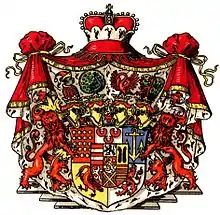Bentheim (noble family)
The House of Bentheim is one of the oldest extant German noble families. They are a mediatized family, formerly being rulers of their own territories directly under the Holy Roman Emperor. They belong to both the ancient nobility (Uradel) and the high nobility (Hochadel). Today, there are two main lines of the family: the princes of Bentheim-Steinfurt and the princes of Bentheim-Tecklenburg. There is also a third, non-princely line of the family, the counts of Bentheim-Tecklenburg-Rheda.

History
The earliest known member of the family is Everwin von Götterswick/Güterswyk, c. 1200, supposedly the descendent of a knight named Godert who had settled on the lower Rhine near Wesel.[1]
In 1421, Everwin's descendent Everwin (1397–1454) inherited the County of Bentheim from his mother's family. In 1451, the Lordship of Steinfurt was also added to the family, through marriage.[2] In 1486, Holy Roman Emperor Frederick III formally recognized Bentheim as an immediate Imperial County; it belonged to the Westphalian College of Counts.[3] The county was partitioned numerous times over the following centuries, notably in 1609, following the death of Count Arnold von Bentheim-Steinfurt.[4]
The Bentheims lost their status as independent rulers in 1806, following the dissolution of the Holy Roman Empire, when they were mediatized by the Grand Dutchy of Berg. At the Congress of Vienna (1814–1815), the counties of Bentheim-Steinfurt and Bentheim-Tecklenburg were assigned to the kingdoms of Hanover and Prussia, respectively. In 1817, King Frederick William III granted both branches the rank of prince; from 1854, both branches had hereditary seats in the Prussian House of Lords.[5][6][7]

The counts of Bentheim-Tecklenburg-Rheda came into being in the 19th century following the morganatic marriage of a prince of Bentheim-Tecklenburg; the King of Bavaria granted their issue the title of counts.[8]
Both princely branches still own numerous historical family properties, including Bentheim Castle, many of which are open to the public.[9][10]
References
- "Haus Götterswick". SV Götterswickerhamm.
- Vollmer, Walter (1963). Westfälische Städtebilder Berichte und Betrachtungen (in German). Gütersloh: C. Bertelsmann Verlag.
- "The Rise of the Counts of Bentheim". Burg Bentheim.
- Rudolf Rübel. 'Graf Arnold von Bentheim-Steinfurt 1554–1606'. In Westfälische Lebensbilder 9 (1962): 18–33.
- Genealogisches Handbuch des Adels, Fürstliche Häuser XIX. "Bentheim". C.A. Starke Verlag, 2011.
- Gothaisches Genealogisches Handbuch: Fürstliche Häuser GGH 7 – Bentheim, II. Linie: Bentheim und Steinfurt, Verlag des Deutschen Adelsarchivs. Marburg, 2018.
- Carl Heiner Beusch. 'Westfälische Standesherren. Die Fürsten von Bentheim-Tecklenburg im 19. Jahrhundert.' In Westfälische Zeitschrift 145 (1995): 257–330.
- Theroff, Paul. "An Online Gotha: Bentheim". Royal Genealogy.
- "Fürstenhaus zu Bentheim-Tecklenburg – Die offizielle Webpräsenz".
- "Burg Bentheim | Die Burg im Münsterland". www.burg-bentheim.de.